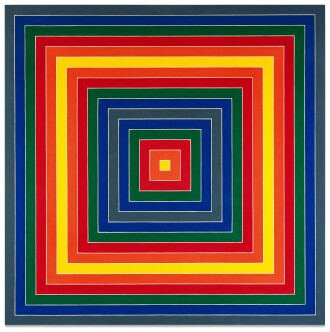Works by Frank Stella at Sotheby's
Frank Stella Biography
One of the most well-regarded postwar American artists still working today, Frank Stella (b. 1936) moved to New York in 1958 after graduating from Princeton, where he majored in history and studied painting. With his first series, “Black Paintings” (1958–60) – in which parallel patterns in black house paint were separated by pinstripes of unpainted canvas – the artist radically departed from his Abstract Expressionist forebears, declared himself a practitioner of nonrepresentational painting (work that is detached from any emotional, intellectual or physical reality) and helped launch Minimalism.
After other series in aluminum and copper, in which he abandoned the traditional rectangular form to create his own shaped canvas, Stella started embracing circular motifs and a brighter palette, such as in Protactor series, with works like Harran (1967). The youngest artist to have a retrospective at the Museum of Modern Art in 1970, he was given another one seventeen years later, a first for a living artist. In the interim, after introducing collage and relief (with paper, felt and plywood), Stella used aluminum as the primary support for his paintings. From the mi-1980s to the mid-1990s, his works became more elaborate, marked by a vivid palette and tangles of curves, spirals and loops. Stella then took on free-standing sculptures and architectural projects. His monumental Prinz Friedrich von Homburg, Ein Schauspiel, 3X (1998–2001) is exhibited outside the National Gallery of Art in Washington, D.C. A dedicated printmaker since the mid-1960s, the artist has also created such works as The Fountain (1992), a mural-sized print utilizing seven processes and 61 colors.
Read Less

















